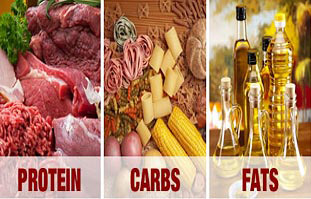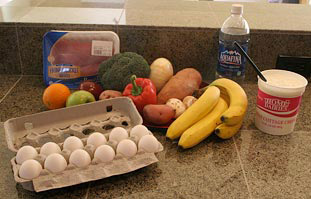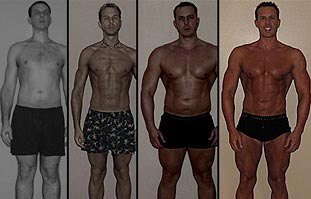YOUR 8-STEP MUSCLE BUILDING & FAT LOSS QUICK START GUIDE

I receive a ton of emails, Facebook messages and YouTube questions every single day from guys and girls all around the world looking to build muscle, lose fat and get into their best shape.
Some questions are very specific and can be answered in a few sentences or less… while others are much broader and would require a full article or video to properly address.
The most common inquiries I receive are from those who are just starting out and simply need to be pointed in the right direction. They’re either looking to bulk up and gain muscle, or lean down and lose fat, and they just need some solid, reliable steps to follow to get on the right path towards their goal.
There is of course no way for me to cover that in a few sentences or less, and that’s why I decided to create this 8-Step Muscle Building & Fat Loss Quick-Start Guide.
This guide will outline the most basic, underlying principles you need to know when it comes to effective natural muscle gain and fat loss.
I will say up front that if you’re looking for a complete, step-by-step guide that covers absolutely everything you need to know in detail along with concrete workout routines, meal plans and supplement plans, you should check out my fully structured Body Transformation Blueprint program.
It cuts through all the hype and B.S out there and gives you a comprehensive, reasonably priced and highly effective approach to building muscle and losing fat if you’re truly serious about maximizing your results.
That said, if you just want to get the major foundational principles down and put together a good starting approach that will help you begin seeing results right away, just follow these 8 simple steps…
Step #1 – Select Your Primary Goal

Regardless of what you may have read elsewhere, in most cases it’s just not realistic that you’re going to build a significant amount of muscle and lose a significant amount of fat at the same time. It can be done in some cases (due to very good genetics or “extracurricular” supplementation), but it’s rare.
So to start off, choose your primary goal, whether it’s to bulk up and build muscle or to lean down and lose fat. Once you’ve reached a level in either direction that you’re happy with, you can change goals if desired.
Step #2 – Determine Your Daily Calorie Needs

If your goal is to build muscle while keeping body fat levels under control, stick to a calorie surplus of 15-20% above your maintenance level. Your maintenance level is the number of calories you require daily in order to maintain your current weight. This will provide your body with the excess energy that is needed to synthesize new muscle tissue.
If your goal is to lose fat while maintaining lean muscle mass, go with a calorie deficit of 15-20% below your maintenance level. This will force your body to burn up its excess fat stores in order to obtain a source of energy.
Your overall calorie intake is the most foundational principle of your entire diet. Without a calorie surplus, you aren’t going to gain any significant muscle, and without a calorie deficit, you aren’t going to lose any significant fat.
Use my Free Macronutrient Calculator to determine your individual daily calorie needs based on your primary goal, sex, age, height, weight and activity level. (The link will open in a new window)
Step #3 – Determine Your Daily Macronutrient Needs

Your total daily calorie intake will determine whether your gain weight or lose weight, and your macronutrient intake (the total daily grams of protein, carbohydrates and fats) will influence what type of body weight is gained or lost, whether it be muscle or fat.
Proteins contain 4 calories per gram, fats contain 9 calories per gram, and carbohydrates contain 4 calories per gram.
My general recommendation to optimize body composition is as follows:
Protein: 1 gram per pound of body weight daily
Fats: 25-30% of total calories for muscle gain, and 15-20% of total calories for fat loss
Carbohydrates: Whatever calories are left over after protein/fat is calculated
The Macronutrient Calculator will also determine these numbers for you.
You certainly don’t need to hit these numbers with exact precision every day, but just try to come reasonably close if you’re serious about achieving the very best results.
Step #4 – Choose The Proper Food Sources

In order to optimize your growth/recovery in between workouts and to ensure that your daily fiber, vitamin, mineral and other micronutrient needs are being met, aim to base your diet around the following foods…
High Quality, Lean Sources Of Protein – This includes foods such as lean poultry, eggs, lean red meat, lean pork, skim milk, cottage cheese, fish/seafood, low fat yogurt and whey. These sources have the highest absorption rate in the body and the strongest amino acid profiles.
High Fiber, Minimally Refined Carbs – Some good examples are oatmeal, rice, quinoa, potatoes, sweet potatoes, yams, ezekial bread, whole grain cereals, pita and pasta. In addition to these sources, always aim to consume 2 servings of vegetables per day and 1-2 servings of fruit per day to ensure that your micronutrient needs are being met.
Healthy, Unsaturated Fats – You’ll receive enough saturated fat from the animal proteins and other tagalong sources you consume, and you should make sure to get in a couple servings of foods high in polyunsaturated and monounsaturated fats as well. Nuts, seeds, natural nut butters, healthy oils, fatty fish, fish oil supplements and avocado are all good choices.
Use an online nutrition database such as CalorieKing.com or My Fitness Pal to configure a daily diet for yourself based on your total calorie/macronutrient needs and the food sources outlined above. (The Body Transformation Blueprint includes step-by-step meal plans to make this easier)
It doesn’t matter how you lay this all out, whether it be 3 larger meals or 7 smaller meals. Just focus on hitting your total calorie/macronutrient needs as a whole from a mix of these various food sources.
Step #5 – Perform 3-5 Weight Training Workouts Per Week

Hit each muscle group directly 1-2 days per week and center your workouts around basic, compound exercises such as squats, Romanian deadlifts, standard deadlifts, bench presses, rows, chin ups, pulldowns and overhead presses.
Including additional isolation exercises is important as well, but these basic compound lifts should form the underlying foundation of your routine.
Make sure that you’ve learned and practiced the proper form for all of your exercises first before applying any significant weight or intensity. You can find many resources online using Google or YouTube to see demonstrations for specific lifts.
Use a low to moderate rep range anywhere from 5-10, with all sets taken at least 2 reps short of concentric muscular failure, and place all of your focus on gradually getting stronger over time by either adding more weight to the bar on your exercises or performing more reps. Keep a workout logbook and track every session in detail, as this will help you progress at the fastest possible rate.
There are many different ways to lay out a weekly weight training schedule, but the routine I like best and outline in
my program is a 3 day split of legs on day 1, chest/shoulders/triceps on day 2, followed by back/biceps on day 3, rotating through each workout throughout the week.
Step #6 – Perform 2-4 Cardio Sessions Per Week

The amount of cardio you perform will largely depend on your specific goal and body type. If you’re aiming to gain muscle while minimizing fat gains, stick to the lower end, and if you’re aiming to maximize fat loss, perform a bit more.
Cardio should ideally be performed at least 8 hours away from your weight training sessions, but if you have no other option, perform it post-workout.
Utilize a mix of both aerobic cardio (low intensity sessions in the 45-60 minute range) and anaerobic cardio (high intensity interval-based sessions anywhere from 8-20 minutes in length).
Step #7 – Include Some Basic Supplements If Desired

Supplements can provide a small boost to your results and make it easier and more convenient when it comes to hitting your daily protein/calorie needs.
This is an area filled with a ton of hype and misinformation, and I’d highly recommend downloading my complete fitness supplementation guide for some honest, no nonsense guidelines to follow:
Complete Fitness Supplementation Guide
Step #8 – Monitor Your Progress And Adjust As You Move Forward

If you’re trying to gain muscle and your weight gain has stalled for more than a 1-2 week period, increase your total calories by 150 and then re-calculate your macros.
If you’re trying to lose fat and your weight loss has stalled for more than a 1-2 week period, decrease your calories by 150 and then re-calculate your macros, or add in an extra cardio session or two during your week. (You can also do a combination of both, for example, lower your intake by 100 calories and perform one additional cardio workout)
Quick-Start Wrap Up
So there you have it, the 8 simple steps you need to follow to get yourself on the proper path towards your fitness goals.
There are of course many smaller details that go into each step, but this covers the most important, foundational principles you need to know to get started and begin seeing progress right away.
Again, if you want a complete breakdown of the entire process along with a concrete training system, meal plans and detailed supplement tips, make sure to check out my complete Body Transformation Blueprint program.
You can also find a ton of additional free advice over on my YouTube Channel and in the Article Archive of this website.
If you found this article helpful, make sure to sign up for your FREE custom fitness plan below...




